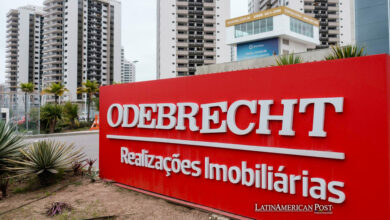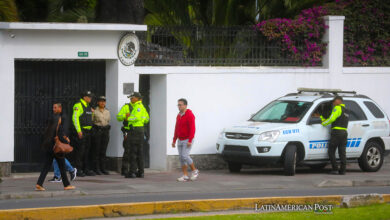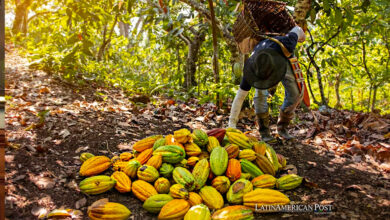The spirit of 9,000-year-old ancestors is ‘reborn’ in Ecuador with its archaeological legacy
The Arutam Wakam Center in Ecuador, which displays artifacts from the ancient Machinaza culture, represents the spirit of ancestors from 9,000 years ago. Discovered during the development of the Fruta del Norte gold mine, these pieces offer a unique insight into early human activity.

12/13/2023.- A person observes an archaeological piece of the Machinaza culture, which inhabited a part of the Ecuadorian Amazon, in Zamora (Ecuador). EFE/ Juan Francisco Chavez
EFE
Escucha este artículo
Leer en español: El espíritu de antepasados de 9.000 años ‘renace’ en Ecuador con su legado arqueológico
The spirit of ancestors who lived about 9,000 years ago in the south of what is now Ecuador is 'reborn' in an Archeology Exhibition Center that houses unique pieces of the Machinaza culture, found in the last decade during the construction and operation of Fruta del Norte, the largest gold mine in the country.
This is the Arutam Wakam Center (Spirit of Our Ancestors, in the indigenous Amazonian Shuar language), inaugurated on Tuesday in the town of El Padmi, in the province of Zamora Chinchipe, bordering Peru.
On the side of the road, a small building acclimatized to counteract the typical humid heat of the Amazon houses a part of what the Archaeological Research Program developed by the mining company over 10 years meant.
Among the finds, there are vessels, remains of plants and food, monoliths, metal pieces, instruments for crushing rock, and remains of metals such as gold, silver, and copper, which demonstrate human activity in the region and date back to 7,000 BC.
In the Center there are – among others – ceramic vessels with different finishes for domestic and possibly ritual use; torteros, which are evidence of spinning activities; a vessel with appliqués representing the hands and arms of a sloth bear, as well as the illustration of a tapir head on a carved stone.
Search in 34 square kilometers
With the financial support of the Canadian company Lundin Gold, in charge of operating Fruta del Norte, the investigation was carried out in a strip of about 17 kilometers long and 2 wide, defined between the Machinaza and Zamora rivers, around the mine, in the rural town of Los Encuentros.
According to the research, the area was inhabited by aboriginal societies from the pre-ceramic Paleoindian period (7,000 years BC) to the integration period (1,500 AD), "before the Inca and Spanish conquest."
María Cristina Acosta, director of Environment and Permits at Lundin Gold, explained to EFE that the study had the authorization and technical control of the National Institute of Cultural Heritage (INPC) and the technical work of the Archaeological and Cultural Research company María Aguilera ( Invacma).
In a tour of the Center, to which EFE was invited, Acosta recalled that the archaeological research process was advancing while the mine was being developed.
"When we saw that there were vestiges, we stopped activities, we recovered those pieces," to begin cleaning and laboratory analysis work with them, some of them in the United States, he commented.
Connection with the Andes
The studies also determined that the Machinaza culture had a connection with areas of the Andes mountain range since the remains found reveal the exchange of products.
"This gives us cultural information about ourselves, about our identity, about our development," he said at the Center, where 74 of the 437 pieces found so far are exhibited, and in whose conservation archaeologists, historians, anthropologists, geologists, restorers participated. , geographers, paleontologists, chemists, biologists, designers, and engineers of various branches, among others.
The Center, which also details how the deposit and operation of Ecuador's first underground gold mine was discovered, is managed and administered by the National University of Loja.
Lighthouse for the future
For Ron Hochstein, president and CEO of Lundin Gold, the Center is an opportunity to promote cultural tourism, to learn about the contributions of the Machinaza culture to history, as well as an example of how private companies can work together with the community. and the State for the benefit of society.
Gabriela Cedillo, director of the INPC in the area, said that the Exhibition Center is not only a testimony of the past but also a "beacon that illuminates the path to the future."
"Archaeology not only excavates layers of the earth but also unearths the roots of our identity, connecting us with those who came before us and providing a solid foundation for generations to come," he stressed.
Also read: Devotion in Mexico City to Honor Our Lady of Guadalupe
That is why he sees in the Center a kind of bridge that unites the past and the present in a journey to understand, appreciate, and transmit.
Each piece, "each corner of this space speaks to us in a silent but eloquent language, about the footprints of those who preceded us," he stressed during the inauguration in which – he said – not only celebrates the opening of a building, but "the birth of a living space that breathes history".





